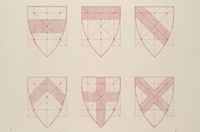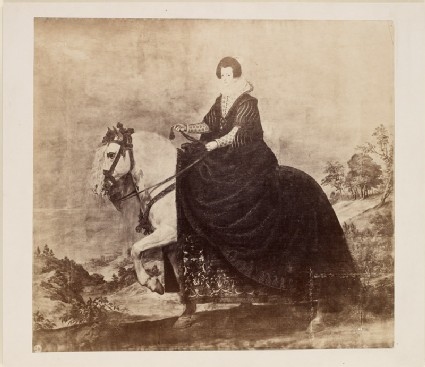Ruskin's revision to the Rudimentary series (1878)
Unpublished manuscript catalogue for proposed re-organisation of the Rudimentary series.

Ruskin's Catalogues: 1 object
Show search help- Reference URL
Actions
Photograph of Velázquez's "Portrait of Isabel of Bourbon on Horseback" anonymous Spanish
-
Ruskin text
R|120–R|122} Portraits of Queens, by Velasquez. Consummate in every quality of realistic art, but purposeless, and indicative of national decline. P. -
Details
- Artist/maker
-
anonymous Spanish (photographer)after Diego Rodríguez de Silva y Velázquez (1599 - 1660)
- Object type
- photograph
- Material and technique
- albumen print
- Dimensions
- 274 x 297 mm (print); 298 x 344 mm (mount)
- Inscription
- Within the photograph, bottom right, a blind stamp, partially flattened: [CUA]DROS DEL RE MUSE[O] [arranged in an oval; within the text the initials:] B.S.M.
On the back of the mount:
left of centre, written up the mount from near the bottom edge, in graphite: R 120
centre, towards right, the Ruskin School's stamp
- Provenance
-
Presented by John Ruskin to the Ruskin Drawing School (University of Oxford), 1875; transferred from the Ruskin Drawing School to the Ashmolean Museum, c.1949.
- No. of items
- 1
- Accession no.
- WA.RS.RUD.120
-
Subject terms allocated by curators:
Subjects
-
References in which this object is cited include:
References
Ruskin, John, The Ruskin Art Collection at Oxford: Catalogue of the Rudimentary Series, in the Arrangement of 1873, ed. Robert Hewison (London: Lion and Unicorn Press, 1984), cat. Rudimentary no. 120, RUD.120
Ruskin, John, Instructions in Practice of Elementary Drawing, Arranged with Reference to the First Series of Examples in the Drawings Schools of the University of Oxford (n.p., [1872]), cat. Rudimentary no. 120-122
Ruskin, John, Instructions in the Preliminary Exercises Arranged for the Lower Drawing-School (London: Smith, Elder, 1872), cat. Rudimentary no. 120-122
Ruskin, John, Instructions in the Preliminary Exercise Arranged For the Lower Drawing-School (London: Spottiswoode, 1873), cat. Rudimentary no. 120-122
Ruskin, John, ‘Rudimentary Series 1878’, 1878, Oxford, Oxford University Archives, cat. Rudimentary no. 110
Ruskin, John, ‘The Ruskin Art Collection at Oxford: Catalogues, Notes and Instructions’, Edward T. Cook and Alexander Wedderburn, eds, The Works of John Ruskin: Library Edition, 39 (London: George Allen, 1903-1912), 21, cat. Rudimentary no. 120
Location
-
- Western Art Print Room
Position in Ruskin’s Collection
Ruskin's Catalogues
-
Ruskin's Rudimentary series, 3rd ed. (1872)
R|120–R|122} Portraits of Queens, by Velasquez. Consummate in every quality of realistic art, but purposeless, and indicative of national decline. P. -
Ruskin's Rudimentary series 4th ed. (1872)
R|120 – R|122} Portraits of Queens, by Velasquez. Consummate in every quality of realistic art, but purposeless, and indicative of national decline. P. -
Ruskin's Rudimentary series, 5th ed. (1873)
R|120 – R|122} Portraits of Queens, by Velasquez. Consummate in every quality of realistic art, but purposeless, and indicative of national decline. P. -
Ruskin's revision to the Rudimentary series (1878)
110.In passing from Angelico to Velasquez we have the complete range of Renaissance art. It will however be seen, by referring to No. 107. that VeR. lasquez is in reality only Carpaccio less crowded, and with a little of the disorder of modernism, or naturalism if we like to call it so, disguising the really monumental and elaborate construction of the picture. The patterns of the Queen’s dress are throughout as formal and as rich as those of the equestrian statue of Colleone & the nonsense which has been talked by modern artists about elaboration of detail may be heard in future with contemptuous silence by the student who has once drawn the beautiful cinque cento pattern of her horsehousings, which, therefore, after doing the pen-exercise on No. 104. the student of decorative art must proceed to do; and at all events one cluster of it is to be drawn in sepia by every student, that they may understand, first, the way in which a great artist does his detail, and; secondly, the mode in which the lustre of flowers seen against shade may be preserved without losing their sgradation. A bit of the fringe of these housings and of the beaded hem of the queen’s mantle should also be drawn and compared with Carpaccio’s similar work.





